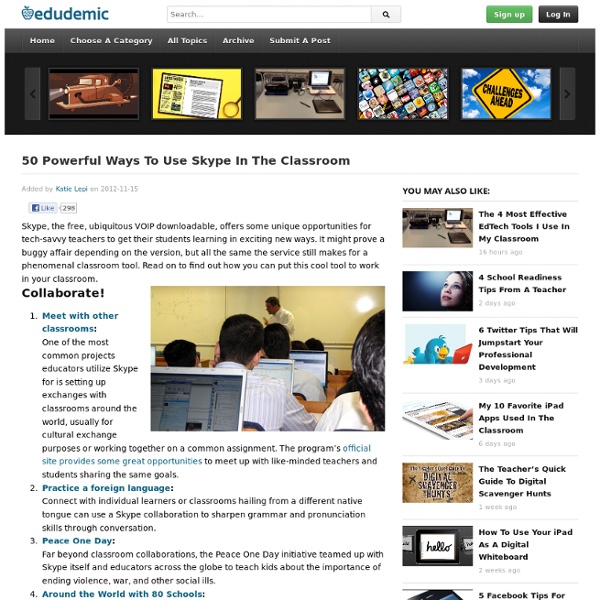7 Cyberlearning Technologies Transforming Education
The year was 1984 and in addition to the chalkboards and alphabet posters, our 2nd grade classroom was equipped with an odd, beige box at a table in the back behind the students. It was an Apple II computer and over the course of the year we'd learn how to operate it - mainly to make a turtle-shaped cursor shuttle across the screen. We would get dedicated time to interact with the computer and, through trial-and-error and with a few tips from our teachers, I and hundreds of thousands of other students across America learned how to turn a turtle into a rocket ship or fill the screen with colors using a computer programming language called Logo on a platform that had less computing power than today's microwaves. Apple Logo II splash screen - Photo credit: Apple2history
Educational technology
Educational technology is the effective use of technological tools in learning. As a concept, it concerns an array of tools, such as media, machines and networking hardware, as well as considering theoretical perspectives for their effective application.[1][2] Educational technology includes numerous types of media that deliver text, audio, images, animation, and streaming video, and includes technology applications and processes such as audio or video tape, satellite TV, CD-ROM, and computer-based learning, as well as local intranet/extranet and web-based learning. Information and communication systems, whether free-standing or based on either local networks or the Internet in networked learning, underlie many e-learning processes.[6]
The problem with the SAMR model
By Trevor Shaw April 27th, 2015 It’s easy to get hung up on the definitions. It isn’t hard to tell the difference between a use that is a simple substitution and one that is a redefinition. It is not always so easy to tell, however, whether a particular use of a collaborative tool is modification or merely augmentation. I firmly believe that it doesn’t much matter.
«Free digital tools in Blooms
This list is distinctive as the resources are a) free and b) almost exclusively browser based. The list is also sorted by Blooms, meaning you are able to more easily consider your student outcomes FIRST. There are a few exceptions. A number of resources listed offer ‘pro’ services, but are still particularly useful using the free services they offer. There are a couple of software downloads included. Notably, Jing and Audacity, which are free and powerful products in the classroom and I felt compelled to include them.
Undercover Teachers or Imaginary Friends?
Nicholas was curious about my identity and the question I had posed to him. He clearly thought the notion of writing to me, a computer, was bizarre—yet he spoke to me with the easy irreverence of a boy addressing an imaginary friend. It was as if I was an echo in the abyss, and the 11-year-old Nicholas was perhaps beginning to wonder if the conversation he was having was in fact with himself. the Evolution of Animals posted by Nicholas 5 on February 05 2015 at 08:40 AM Dear Question-writer[a.k.a. the Computer]I think that Michigan is trying to say that different kinds of animals live on top of her, and the different species of animals evolve into different animals, and become even more different as those evolve too.
An Ed-Tech Guide for Teachers and Technologists
“Ed-Tech” stands for educational technology, it is about the education-focused technologies or using general technologies for education purposes. Looking back on 2012, a review on Top 10 Educational Technologies of 2012 (from School Library Journal) is a must-read, and Top 100 Tools for Learning from C4LPT (2012) is the comprehensive list of top Ed-Tech tools from C4LPT. Looking forward to next year, MIT Enterprise Forum gave us the highlight on Converging Trends and Opportunities of K12 EdTech, and The Open University proposed ten innovations that have the potential to provoke major shifts in educational practice: Innovating Pedagogy 2012 from The Open University. Back to the basics of Ed-Tech, Audrey Watters(Hack Education) had created “The Audrey Test” in 2012 – … some of the things I think techies (engineers and entrepreneurs) should know about education.
A Teacher’s View on a Geeky “EdTech” Conference — Bright
Last week, I had the opportunity to attend the ASU/GSV Summit in Scottsdale, Arizona, the premier conference on educational technology (or “EdTech”). Over 2,500 innovators and entrepreneurs were in attendance, discussing new trends in iPad software and online curriculum. Everyone was working, in some way, to improve teaching and learning for tomorrow.
Top 5 Lectures about Education & Technology
Learn About EnglishCentral Teaching English Magazine Read The Latest Newsletter Digital Downloads TESOL Certificate Supporter Top 5 Lectures about Education & Technology This is a follow up to my recent: Top 5 Inspirational presentations about Educational Technology.
How to Grow a Classroom Culture That Supports Blended Learning
The excerpt below is from the book “Moonshots in Education: Launching Blended Learning in the Classroom,” by Esther Wojcicki, Lance Izumi and Alicia Chang. This excerpt is from the chapter entitled “Trick in the Blended Classroom,” written by Wojcicki. It all started in 1987, when I got a grant from the State of California. The state sent me eight Macintosh computers, never asking if I knew how to use them, and when they arrived I had no idea how to even turn them on. I realized then that I was going to fail if I didn’t get some help quickly.
100+ examples of use of social media for learning
EmailShare 0EmailShare Note: this page dates back to 2011. More up to date information is to be found in my Social Learning Handbook 2014. Here are over 100 ways that different social technologies (and tools) are being used by learning professionals worldwide – compiled from the comments of those who have contributed to the Top 100 Tools for Learning 2009 activity. Blogging (1) “Blogs are great for learning from others, reflection, story sharing, facilitating connections among people, philosophizing, and much more” Janice Petosky, Instructional designer,West Chester, Pennsylvania



